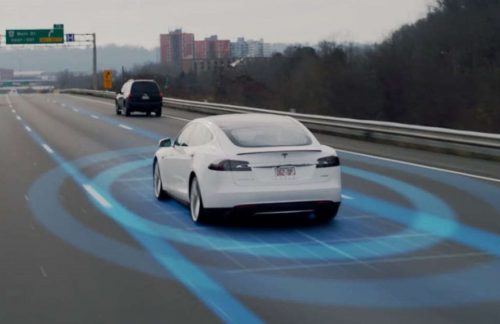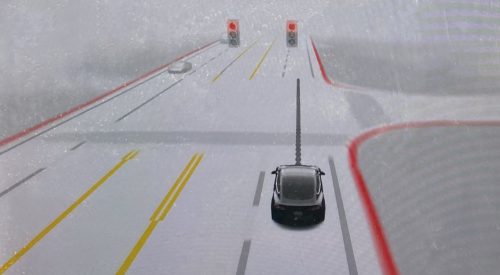
Our upcoming Model Y, like all Teslas, come with some self-driving features but others are optional. The term “Autopilot” has a lot of features that may or may not be included with any given Tesla so in this post, I’ll try to demystify what they mean.
All Teslas come with Traffic Aware Cruise Control. This is very similar to what is found on a lot of other cars, though it’s fancier than cars that I’ve owned. When you engage cruise control, it will attempt to drive at the speed you’ve set. The max speed can be easily adjusted with the thumb scroll on the right side of the steering wheel. If a car in front of you is going slower than the max speed, it will follow at whatever distance you’ve configured. You can also configure the cruise control to always be set to X mph over the speed limit or X% over the speed limit. The cruise control will automatically adjust to the current speed limits. The car will automatically begin to slow down for situations like exit ramps (it uses the average speed of cars that have gone before you) or if someone pulls out in front of you. It will even bring you to a complete stop if the car in front of you stops. If you’re following a slow vehicle and you use your turn signal to switch lanes, the car will automatically speed up to your desired speed if no one is in front of you. I use cruise control a lot but frequently end up disengaging it to deal with traffic so I think I’m really going to enjoy this feature.
All Teslas also come with Autosteer. After the cruise control is engaged by clicking down on the right stalk, clicking down again will enable autosteer. Autosteer is recommended to be used on highways and interstates, but it can be enabled on almost all roads. This is a differentiator from systems like “Blue Cruise” which only work on specific roads. The autosteer system does what it sounds like: it steers the vehicle for you. We tried this out on our test drive and it was creepy and awesome at the same time. You must keep your hand on the wheel at all times and give it a little tug every 30 seconds or so to let it know that you’re still paying attention. If you really drive hands off and ignore what’s going on, you’ll get progressively stronger warnings until the system disables itself. (Drunk drivers have found themselves pulled over on the side of the road automatically.) The system isn’t perfect but from reading reviews, people almost unanimously agree that it reduces stress especially on long drives. You don’t realize how much effort it takes to just stay in your lane for hours at a time until you don’t have to do it anymore. I don’t know how much use we’ll get out of this feature around town, but it makes me excited to take a road trip and let the car handle a lot of the driving for me.
There are other features like Autopark, Lane Assist and Collision Avoidance Assist which have multiple options that can be configured. For example, maybe I just want a chime if I’m drifting out of my lane in most cases, but if I’m drifting into oncoming traffic and a collision is imminent than take over and get me back into my lane.

The next big features is commonly referred to as the Full Self Driving (FSD) beta but it includes things like Navigate on Autopilot, Traffic Light and Stop Sign Control, and Smart Summon. These features are not enabled by default and currently cost $10,000 extra. Smart Summon tells your Tesla to move to your location. It will exit its parking spot and come to you. I could see this being a fun party trick but the car moves too slowly or gets too confused in busy parking lots to be useful. The first two are the ones that are making all the news. With these features, you can get in your car, pick a destination, and let your car drive you there. You are still responsible and need to have your hands on the wheel but it will change lanes, make turns, and stop for traffic signals. The $10,000 price tag is hefty and most buyers do not opt for it, but Tesla is now offering a $200/month subscription service to temporarily enable them. This works because all the cars have the required hardware in them.
The Full Self Driving feature is still in beta and honestly, it’s probably a poor choice of name. This is generally considered to be a Level 2 self driving feature. The levels range from 0-5 and at level 2, there’s still a lot of responsibility on the driver. Tesla is furiously working to move up the levels, but for now “full self driving” is aspirational.
Waymo is one of the leaders in this space. They’re probably a level 4. If you’re in Phoenix, you can call a Waymo self-driving taxi to your location, get in the back seat, and then proceed to your destination with no human driver. (If you’re intrigued by this idea, check out Malcom Gladwell’s Revisionist History podcast episode titled I Love You Waymo.) It’s only level 4 because it works in a ring fenced area of Phoenix. You can’t tell it to drive you across the state, but like Tesla, they’re working hard to improve.
The tech side of this is amazing. Tesla has billions of hours of driving footage form their cars and they use this to train their models over and over again. They’re building their own supercomputers that specialize in these types of computations and employ armies of the smartest AI engineers. They held an impressive AI Day event in August and you can either watch the full event or get a 19 minute version of it.
While the tech and the enormous amounts of computing power are exciting to me, I’m also excited about the safety aspect. While it’s uncomfortable, the safety records of these systems already put humans to shame. 80-90% of people think they are an above average driver so it’s no surprise that people think they’ll drive better than a computer, but if you’re in that camp, watch that AI day footage and tell me that you’re processing that much information about your environment every second without a single lapse of attention. With so many Teslas on the road, there is already plenty of data to show how much safer it is to let computers drive. As of April the NHTSA says there is an accident every 484,000 miles, but if you’re driving a Tesla with Autopilot engaged, there’s only an accident every 4,190,000 miles. It’s not a totally fair comparison because there are some situations where Autopilot won’t engage, but still, they are approaching 10x better safety than humans. It doesn’t stop there though. Tesla is continuously improving and pushing out software updates on a regular basis to all the cars. They track the accident rates and it keeps going down as they improve. The computers have a lot of hubris to overcome, but the data is on their side.
So while it seems futuristic to have a car steering for you, the future is now… and Tesla has been doing it since 2015. With the rate at which they are progressing, it’s not hard to imagine that by the time I’m retired and too old to drive safely, I won’t have to drive at all, but I’ll still be able to get around.
